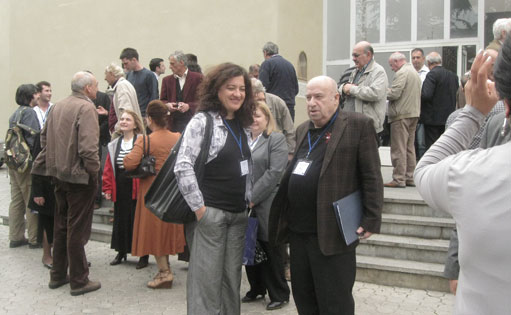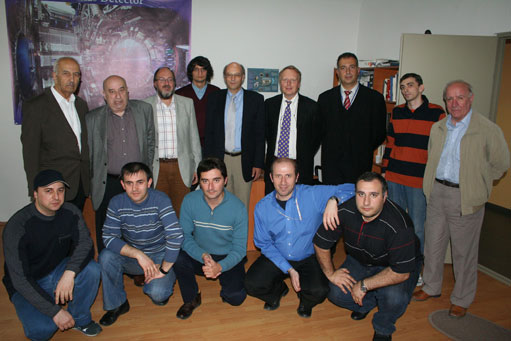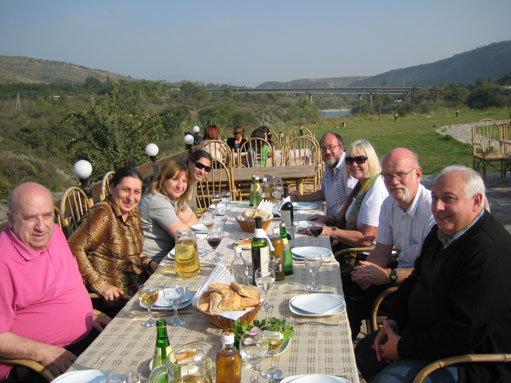
ATLAS e-News
23 February 2011
ATLAS and LHC in Georgia
13 January 2010
Ever since 1994, a joint team from the Institute of Physics of the Georgian Academy of Science and of the Javakhishvili Tbilisi State University (TSU) has worked on the ATLAS experiment. The recent international conference on ‘Physics at the Future Colliders 2009’ held at the Berdzenishvili International Centre of Culture ‘Muza’ in Tbilisi was an excellent occasion to review and energise this long-standing cooperation just before LHC start-up with the participation of a strong ATLAS and CERN delegation. The famous Georgian hospitality also made it a memorable visit for all, with many occasions to celebrate old friendships.
The Georgian ATLAS team, which currently has some 12 colleagues and has been led since the beginning by Jemal Khubua, has contributed to all phases of the Tile Calorimeter, so it is no surprise that both participation from, and talks about, the Tile Calorimeter were well featured in the programme, with Project Leader Ana Henriques setting the frame. However the conference reviewed in much broader terms LHC as a whole, spanning from theory to experimental aspects, engineering, computing and the machine with a firsthand report by former Project Leader Lyn Evans. Aspects of the CERN cooperation in the Caucasian States were reviewed by CERN’s non-member state advisor Tadeusz Kurtyka, and Peter Jenni had the privilege to conclude the conference looking back over the full LHC project as well as recalling the fruitful collaboration of Georgian colleagues in ATLAS. Besides their involvement in the Tile Calorimeter, their work also includes the physics of rare Flavour Changing Neutral Current (FCNC), Top decays and computer-aided engineering design.
Irakli Minashvili, now at JINR Dubna, who leant a helping hand to the organisers, explains how the conference came into being: “For the economy of Georgia and for science itself, the beginning of 2000 was a very difficult period and UNESCO [the United Nations Educational, Scientific and Cultural Organization] tried to help us rescue the situation, to keep the high level of education and, in particular, fundamental research in physics.” The gathering has taken place biennially since 2001, with the first three being funded by UNESCO and the Georgian Academy of Sciences, and the latest two supported by TSU and the Ministry of Sciences and Education of Georgia. “Now the aim of the conference is a little different,” says Irakli, it is “not only to rescue Physics, but also to help Georgian physicists working outside of Georgia and a new generation of physicists meet and discuss, with invited foreign scientists, the up-to-date situation in high energy and particle physics.”

Conference coffee break with Ana Henriques and Jemal Khubua in the foreground
Since the early 2000s, ATLAS has enjoyed a fruitful cooperation with the Georgian CAD/CAM Engineering Centre (GCCEC) which has taken responsibility in managing the huge ATLAS 3D CATIA design database and tool kit. A novel feature is a shared virtual design office between CERN and Tbilisi. Its director, Alexander (Lasha) Sharmazanashvili, illustrated at the conference with impressive examples how his group found critical engineering issues, for example during the virtual installation of the ATLAS End-Cap Toroids, in time for the real action at Point-1. “We had to work out how this monster was going down”, says Lasha.
The ‘official’ ATLAS delegation had some representative duties as well, before relaxing in the friendly atmosphere of the Georgian settings. On the agenda were formal visits for Peter Jenni together with Jemal Khubua to the President of the Georgian Academy of Science, with the Rector of TSU, and of a larger delegation including also Lasha, Markus Nordberg and Dario Barberis to the Deputy Minister of Education and Science of Georgia, Nodar Surguladze. Mr Surguladze expressed an encouraging interest in (and mention of financial support for) broadening cooperation with CERN and ATLAS on software developments via the GCCEC. Some of the meetings and talks were followed by a Georgian TV crew, who made interviews and even visited CERN two weeks later for further footage.

In the offices of GCCEC
However, what remains also deep in the memories of all are the many great moments of relaxing with the Georgian colleagues during the famous delicious meals, and enjoying old Tbilisi and the historic places surrounding it. There was the day tour to the old town of Sighnaghi, and the great privilege of a visit to the National Sculptor Merab Berdzenishvili in his home, which is in fact a real private museum. The emotional highlight of the social events was the special invitation to follow a general repetition of the world-famous Georgian national folk song and dance State Academic Ensemble ERISIONI. Only meters away from the artists the guests could follow the moving and lovely folk dances as well as the fierce and scaring performance of the sword dance group. On the last sunny day the guests enjoyed a tour to nearby Mtskheta, the ancient capital of Georgia, with its famous cathedral and the Jvari Monastery. Peter Jenni recalls: “It was in 1996 when I was brought here for the first time by my ATLAS friends from Tbilisi, and since then Georgia means something special to me”. And in the words of Markus Nordberg: ”The Georgian people are as warm as their weather”.

At the Erisioni rehearsal

Good-bye lunch near Mtskheta
 Peter JenniCERN |
 Ceri PerkinsATLAS e-News
|